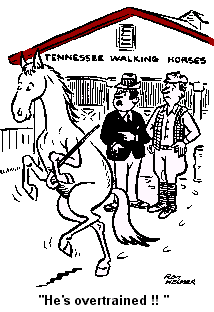
OWNERS RON AND JOHANNA GREEN

Originally bred as a utility horse, the Tennessee Walking Horse is presently best suited for a recreational mount due to its smooth easy ride and its gentle disposition. Calm, docile temperament, combined with naturally smooth and easy gaits insure the popularity of the Tennessee Walking Horse as the world's greatest show, trail and pleasure horse.
The Tennessee Walking Horse is a light horse breed founded in middle Tennessee. This breed is a melting pot much like Americans it is a composition of the Standardbred, the Thoroughbred, the Morgan, and the American Saddlebred stock.
The Tennessee Walking Horses generally range from 14.3 to 17 hands ( a hand being 4 inches) and weigh 900 to 1200 pounds. The modern Tennessee Walking Horse possesses a pretty head with small, well placed ears. The horse has a long sloping shoulder, a long sloping hip, a fairly short back and a short strong coupling. The bottom line is longer than the top line, allowing a long stride.
Color: Tennessee Walking Horses come in all colors and all patterns. The wide variety of range in color is sure to please everyone as there is no discrimination in color. Black, bay, chestnut, palomino, buckskin roan and spotted patterns are apparent on the smooth riding Tennessee Walking Horse.
Gaits: The Tennessee Walking Horse performs the flat foot walk, running walk, and canter. These three are the gaits for which the Tennessee Walking Horse is famous, with the running walk being an inherited natural gait unique to this breed.
Many Tennessee Walking Horses are able to perform the rack, stepping pace, fox-trot, single-foot and other variations of the famous running walk, while this is not desirable in the show ring the above mentioned gaits are smooth easy trail riding gaits.
The flat foot walk is a brisk, long-reaching walk that can cover from 4 to 8 miles an hour. This is a four cornered gait with each of the horse's feet hitting the ground separately at regular intervals. The horse will glide over the track left by the front foot with his hind foot (right rear over right front, left rear over left front). The action of the back foot slipping over the front track is known as overstride.
Overstride is unique to the walking horse breed. The hock should show only forward motion, with vertical hock action being highly undesirable. A Tennessee Walking Horse will nod its head in rhythm with the cadence of its feet. This nodding head motion, with the overstride, are two features that are unique to the Tennessee Walking Horse. This unique head motion along with overstride are two things the judge should take into consideration when judging a Tennessee Walking Horse.
The running walk is the gait for which the walking horse is most noted! This extra-smooth gliding gait is basically the same as the flat walk with a marked increase in speed. This breed can travel 10 to 20 miles per hour at this gait. As the speed is increased, the horse over-steps the front track with the back foot by from 6 to 18 inches. The more "stride" the horse has the better "walker" it is considered to be, for this gives the rider a feeling that he or she were gliding through the air as if propelled by some powerful but smooth-running machine.
Walking horses relax certain muscles while doing the running-walk, some nod their heads in rhythmic timing, swing their ears in perfect motion, and some even snap their teeth. The running walk is a smooth, easy gait for both horse and rider.
The running walk is basically the same gait as the flat walk with an increase in speed. There should be a noticeable difference in the rate of speed between the flat walk and the running walk, but a good running walk should never allow proper form to be sacrificed for excessive speed. A true Tennessee Walking Horse will continue to nod while performing the running walk. Judging should not be influenced by speed, but rather by the true form exhibited.
The third gait is the canter, which is a collected gallop. The canter is performed in much the same way as other breeds, but the walking horse seems to have a more relaxed way of performing this gait. The canter is a forward movement performed in a diagonal manner to the right or to the left. On the right lead, the horse should start the gait in this order: left hind, right hind and left fore together-then right fore. The order for the lead is: right hind, left hind and right fore, then left fore.
When performed in a ring, the animal should lead his canter with the fore leg to the inside of the ring. In the canter the horse gives one the abundance of ease with lots of spring and rhythm, with the proper rise and fall to afford a thrill from sitting in the saddle. Thus the canter lifts with the front end giving an easy rise and fall motion that is likened to a rocking chair. This is often referred to as the "rocking-chair-gait".
Information on this page provided by Internation museum of the Horse supplied by the Tennessee Walking Horse Breeder's and Exhibitors' Association.